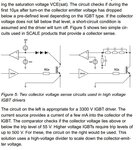7rots51
Advanced Member level 4
I want to protect IGBT from short circuit protection using Vcesat ,I want to use HCPL-316J optocouplers.
My IGBTs are 1200V,100A.
My question is :
Vcesat turn off IGBT when Vce reaches to about 8V when current of IGBT rises,but accorcing to Ic-Vce curve of IGBTs at currents 2x to 5x of nominal current Vce become about 4V,so how protection circuit protect IGBT? It beed 8V for protection!
Please clear this concept for me.
My IGBTs are 1200V,100A.
My question is :
Vcesat turn off IGBT when Vce reaches to about 8V when current of IGBT rises,but accorcing to Ic-Vce curve of IGBTs at currents 2x to 5x of nominal current Vce become about 4V,so how protection circuit protect IGBT? It beed 8V for protection!
Please clear this concept for me.

